|
|||||||||
|
ARTICLESCarpets for Kangxi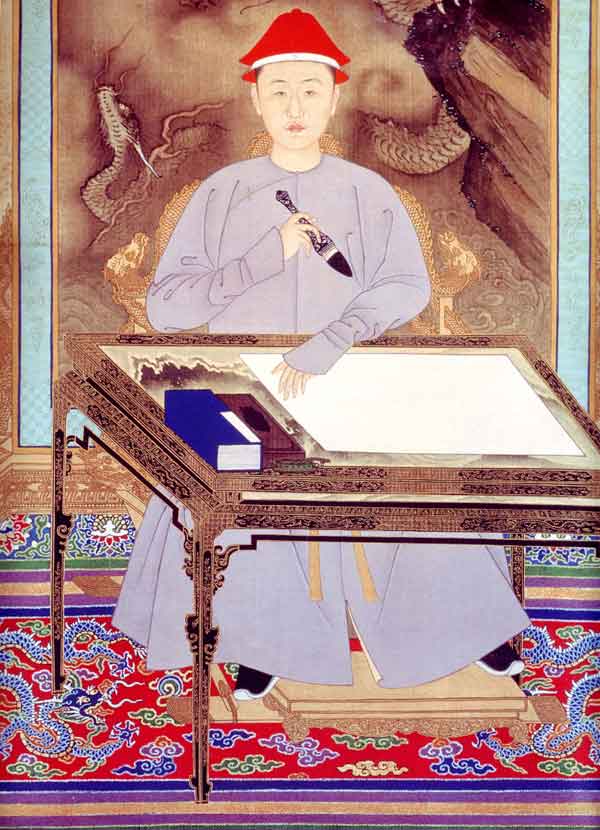 Fig.1 Portrait of the Kangxi Emperor at his Writing Table, anonymous, scroll painting on silk, 50.5x31.9cm. Palace Museum, Beijing. Beneath the emperor is a typical red ground Ming dynasty carpet, probably made some sixty years earlier for the Wanli Emperor of the Ming. As far as can be ascertained, this carpet does not survive in the Palace Museum today. Thirty-one Wanli period carpets depicting dragons and clouds extant. All of these were originally on this typical red ground but most have changed colour. Eighteen of these are in the Palace Museum. MF. Source: Michael Franses, Classical Chinese Carpets in Western Collections: The Kangxi Period, 1661-1722, London, 2002, plate 1. Until the quelling of the Muslim rebellions in the 19th century, Qinghai, Ningxia and Gansu had centres for the production of woollen carpets that appealed to the tastes of the ruling Manchus. There were two major traditions of carpet making in the north-west of the Qing empire—one Tibetan, the other Muslim. These two traditions often fused in the actual works produced-in response to the demand for carpets from these two ethnic groupings, from Manchu and Mongol aristocrats, and from the foreigners and trading firms based in cities in eastern China. 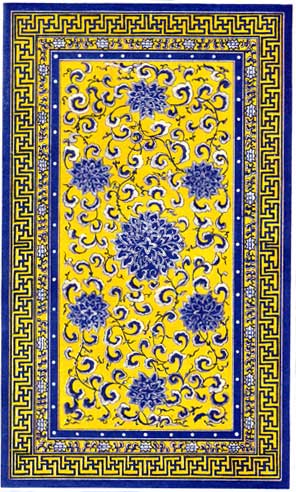 Fig.2 Yellow carpet of the Imperial Palace in Peking. Source: Adolf Hackmack, Chinese Carpets and Rugs, Tientsin, 1923, n.p. The patterns or designs found in the porcelain of the Ming dynasty, especially the Muslim floral motifs, were often replicated in carpets. (Fig.2) During the Qing dynasty in particular these were augmented by the widespread use of the eight Buddhist emblems of good augury (Fig.3), the eight treasures of the Chinese literatus, (Fig.4) and various auspicious motifs based on popular Chinese-language rebus items (for example, the 'bat', bianfu in Chinese, connoted its homophone 'good fortune'). (Fig.5) Major marts in the carpet trade and production centres were Liangzhou (Wuwei) and Lintao in Gansu. Even though most centres of woollen carpet production, even those in Xinjiang, have been monopolised by marketing and export agencies based in Tianjin and other cities of the eastern seaboard, carpets are still made at factories in industrial centres in the north-west. For example, Wuwei continues to produce Apsara (Feitian) brand carpets, said to be China's best woollen carpets, while Lintao is said to produce the most expensive. Furniture and carpets were aspects of the history of material cultural tradition long neglected by mainland scholars of Chinese antiquities; most of the world's leading scholars and collectors are outside China. Within China, the collecting of carpets is little developed outside Tibetan and Muslim societies whose demands are often more practical: temples and mosques constantly require new carpets for worshippers and to decorate columns. Only the Mongol and Manchu courts can be said to have included connoisseurs of carpets, and we see examples of Muslim carpets in some of the figural paintings and examples of portraiture that were produced by Qing court artists. (Fig.6) More recently, Tibetan carpet making skills were listed for Huangzhong county, outside Xining in Qinghai province, as one of China's more than 500 intangible cultural heritage items, specifically item no. 371, and many examples of this type of carpet can be seen at sKum-sbum (Ta'rsi monastery). Chinese Tibetan carpets, especially those of the area outside Amdo (Qinghai), have been better studied than have the Muslim carpet making traditions of China's three north-western provinces. An excellent article by Ted Worcester on the Tibetan view of aesthetics, as relevant to the Nepalese-Tibetan carpet, is available on line at: http://www.asianart.com/articles/carpets/index.html. 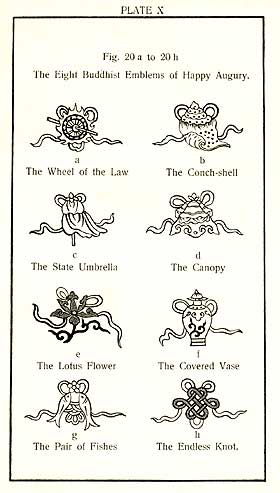 Fig.3 Source: Adolf Hackmack, Chinese Carpets and Rugs, Tientsin, 1923, plate X. 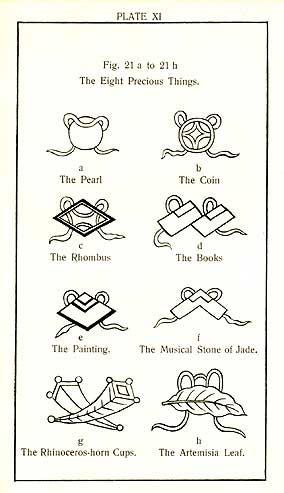 Fig.4 Source: Adolf Hackmack, Chinese Carpets and Rugs, Tientsin, 1923, plate XI. Although some Western collectors once believed that Tibetan carpets were made in imitation of Chinese Muslim carpets, this is now known to be false. Worcester writes:
 Fig.5 Detail of the Scofield Thayer octagons and 'squares and squares' dais carpet, see plate 6. MF. Source: Michael Franses, Classical Chinese Carpets in Western Collections: The Kangxi Period, 1661-1722, London, 2002, plate 6, detail. Again, the Muslim carpet traditions of China have been better documented by Western scholars than they even have been by the Chinese who catered to the passion of some Western connoisseurs and collectors for the carpets of Ningxia and Suiyuan from the 19th century onwards. Many studies have appeared in Western languages, but a pioneering book was Adolf Hackmack's Chinese Carpets and Rugs published in Tianjin in the 1920s. It is only within the last decade that the Palace Museum in Beijing has even moved to catalogue and attempt to preserve its own collection of Muslim and Tibetan carpets. Because the collection was held in such disdain, even by serious-minded antiquarians and scholars, one can only imagine how many thousands of rugs were looted, pilfered or simply sold as job lots from the Forbidden City over the last century. This disregard by 20th-century curators for carpets was not shared by the illustrious inhabitants of the Forbidden City during the early-Qing period. They frequently appear in paintings by court artists, and even in portraits of members of the imperial family, not least the emperor. The Kangxi Emperor commissioned the weaving of a 70 sq m carpet with dragon motifs to be set below the central throne in the Hall of Supreme Harmony (Taihe Dian), the most revered site in the Forbidden City, and it is still there today. The carpet was installed after Kangxi completed the total reconstruction of the hall in 1697. 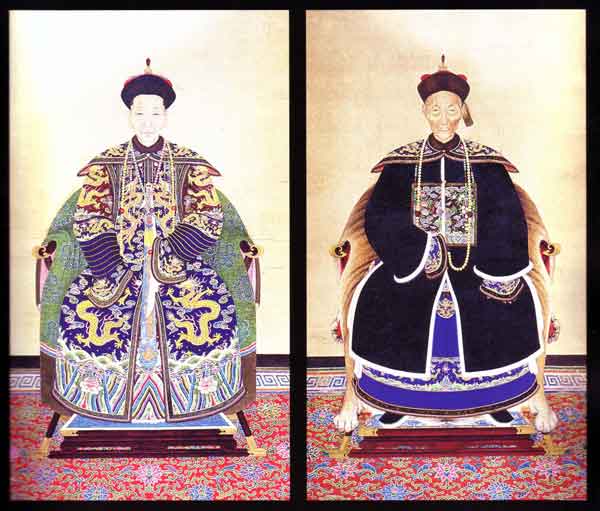 Fig.6 A pair of ancestor portraits, anonymous, scroll painting on paper, early or mid-nineteenth century. Each 93x160 cm. Private collection. The portraits depict a military office of the second rank and his wife in full court dress seated upon a pair of sixteenth-or early seventeenth-century huanghuali folding chairs inset with shows its original red ground. The style of the costumes dates the paintings to the early or mid-nineteenth century, which shows that the nobility at that time were pleased to be painted with beautiful antiques. MF. Source: Michael Franses, Classical Chinese Carpets in Western Collections: The Kangxi Period, 1661-1722, London, 2002, plate 10. The division of the palace manufactories responsible for carpet making was the workshop for pizuo, literally meaning 'the production of hides and furs'; this was still operational during the reigns of the Yongzheng and Qianlong emperors and was directed from the emperor's office in Hall of the Cultivation of the Mind (Yangxin Dian). Until the mid-Qing dynasty, the Qing palace workshops produced carpets for the court that featured either dragon motifs (for the emperor) (Fig.7), or phoenix motifs (for the empress and palace ladies). The Hall of Union (Jiaotai Dian), where the empress received the court ladies and officials on the occasion of her birthday, was decorated with a large carpet measuring 4.5 x 4.35 m, which was emblazoned with the double-phoenix motif. Throughout the Qing dynasty, carpets from the north-west were collected or received as tribute (Fig.8), but in the last half of the Qing dynasty carpets were no longer made by the palace workshops and the collected carpets ceased to be valued. [BGD; © Bruce Gordon Doar] 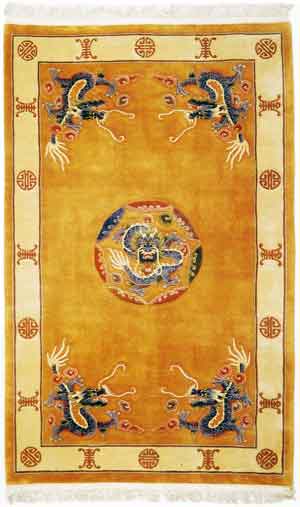 Fig.7 Dragon medallion design with Shou ('Longevity') borders (workshop, China). Source: Lee Allane, Oriental Rugs, A Buyer's Guide, plate 29. 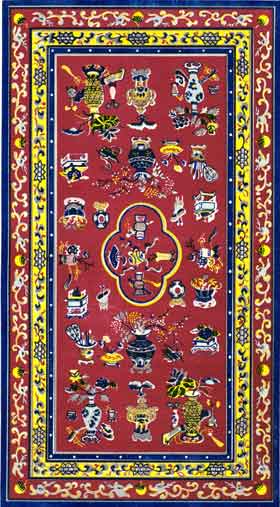 Fig.8 Red carpet of the Imperial Palace in Peking. Source: Adolf Hackmack. Chinese Carpets and Rugs, Tientsin, 1923, n.p. Notes:[1] Ted Worcester, op.cit. This article first appeared in The Nepalese-Tibetan Carpet, edited by John Frederick, a special issue for the carpet trade published by Nepal Traveller, January 1993; one of a series of issues on Himalayan carpets. Asianart.com will be publishing further articles from this now rare series. |